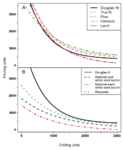Xenie
Seedling
Long time listener, first time caller.
I have been studying quite a bit about the effects of a warming climate on boreal forests. The researchers seem to be suggesting that a number of timer tree species will have spring bud burst issues due to warming winters. The cold induced dormant period will be affected by warming winters. This got me wondering about my collection. This is my first winter with a number of conifers, so the spring will be my first time experiencing bud burst for many of these. I live in San Francisco, where winter lows average about 50 degrees F. I have read that various amounts of “chill hours” at ~ 40 degrees F are required for many conifers to properly bud burst in spring (400+ Hours in most cases). The climate change researchers suggest that bud production and spring burst is negatively affected when the required chilling hours are not achieved. Yet, we have spruces and Doug Firs etc. as street trees (not super plentiful, but quite a few) and arboretum specimens. So, I guess long story short — does anyone have experience growing cold hardy conifers in temperate coastal winters?
I have been studying quite a bit about the effects of a warming climate on boreal forests. The researchers seem to be suggesting that a number of timer tree species will have spring bud burst issues due to warming winters. The cold induced dormant period will be affected by warming winters. This got me wondering about my collection. This is my first winter with a number of conifers, so the spring will be my first time experiencing bud burst for many of these. I live in San Francisco, where winter lows average about 50 degrees F. I have read that various amounts of “chill hours” at ~ 40 degrees F are required for many conifers to properly bud burst in spring (400+ Hours in most cases). The climate change researchers suggest that bud production and spring burst is negatively affected when the required chilling hours are not achieved. Yet, we have spruces and Doug Firs etc. as street trees (not super plentiful, but quite a few) and arboretum specimens. So, I guess long story short — does anyone have experience growing cold hardy conifers in temperate coastal winters?

